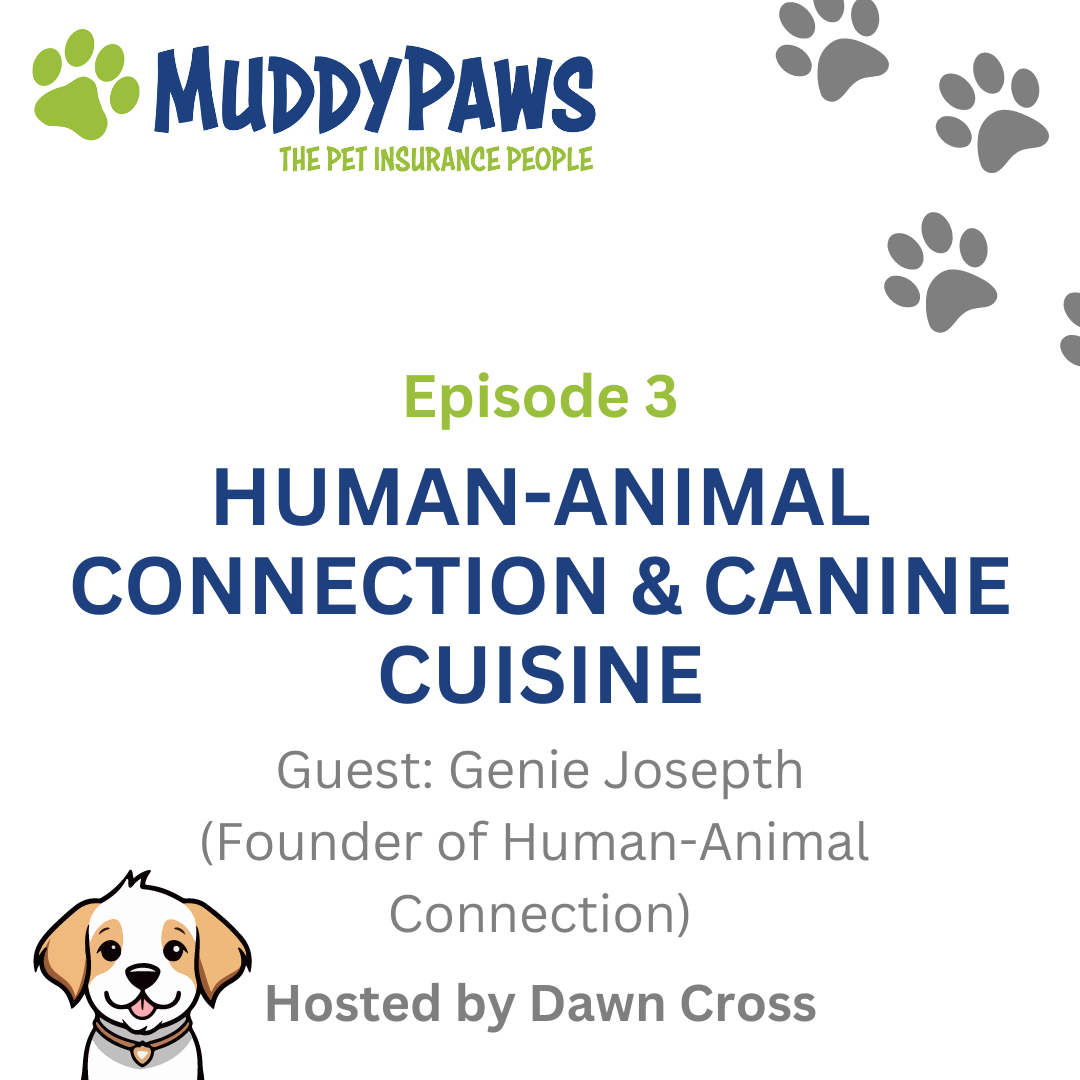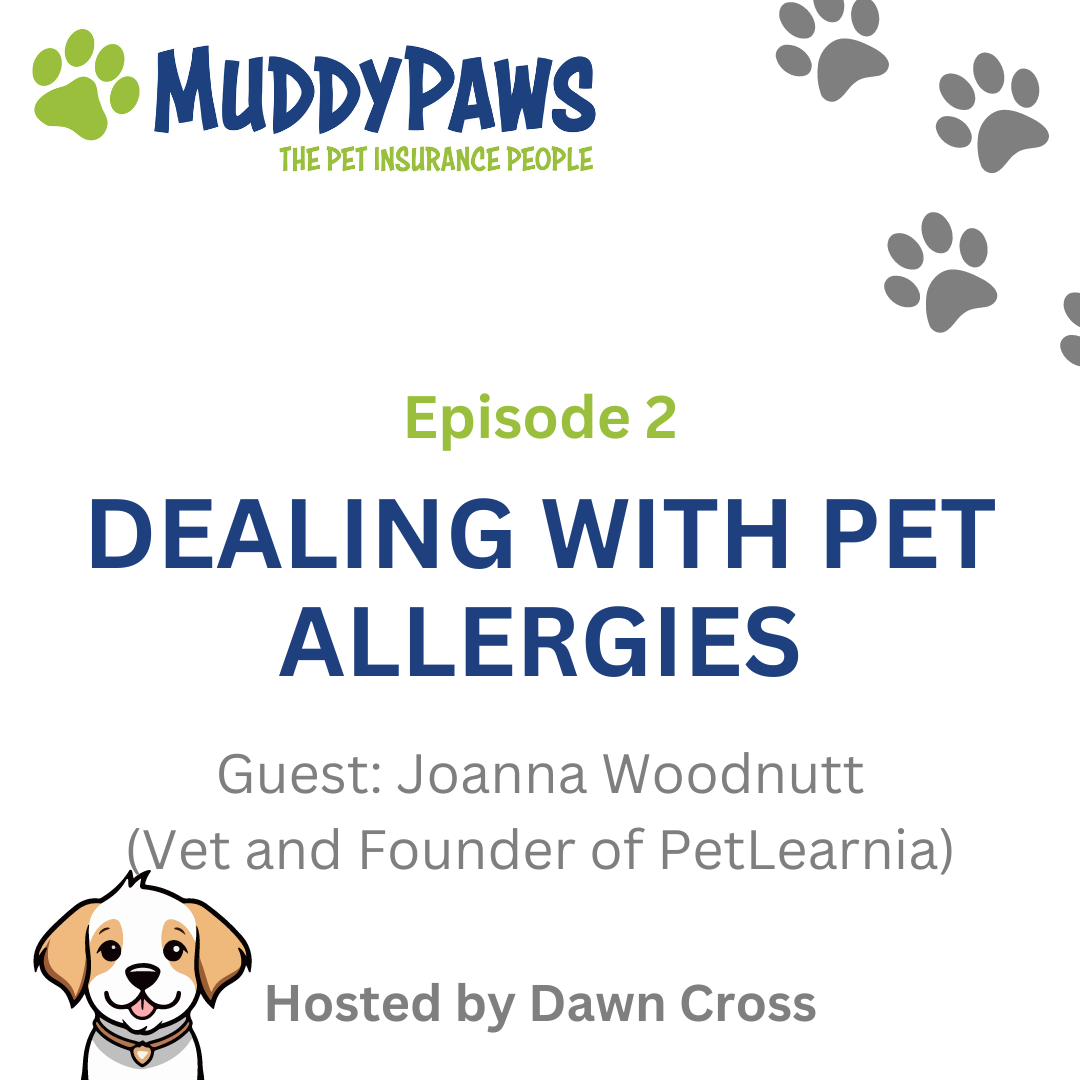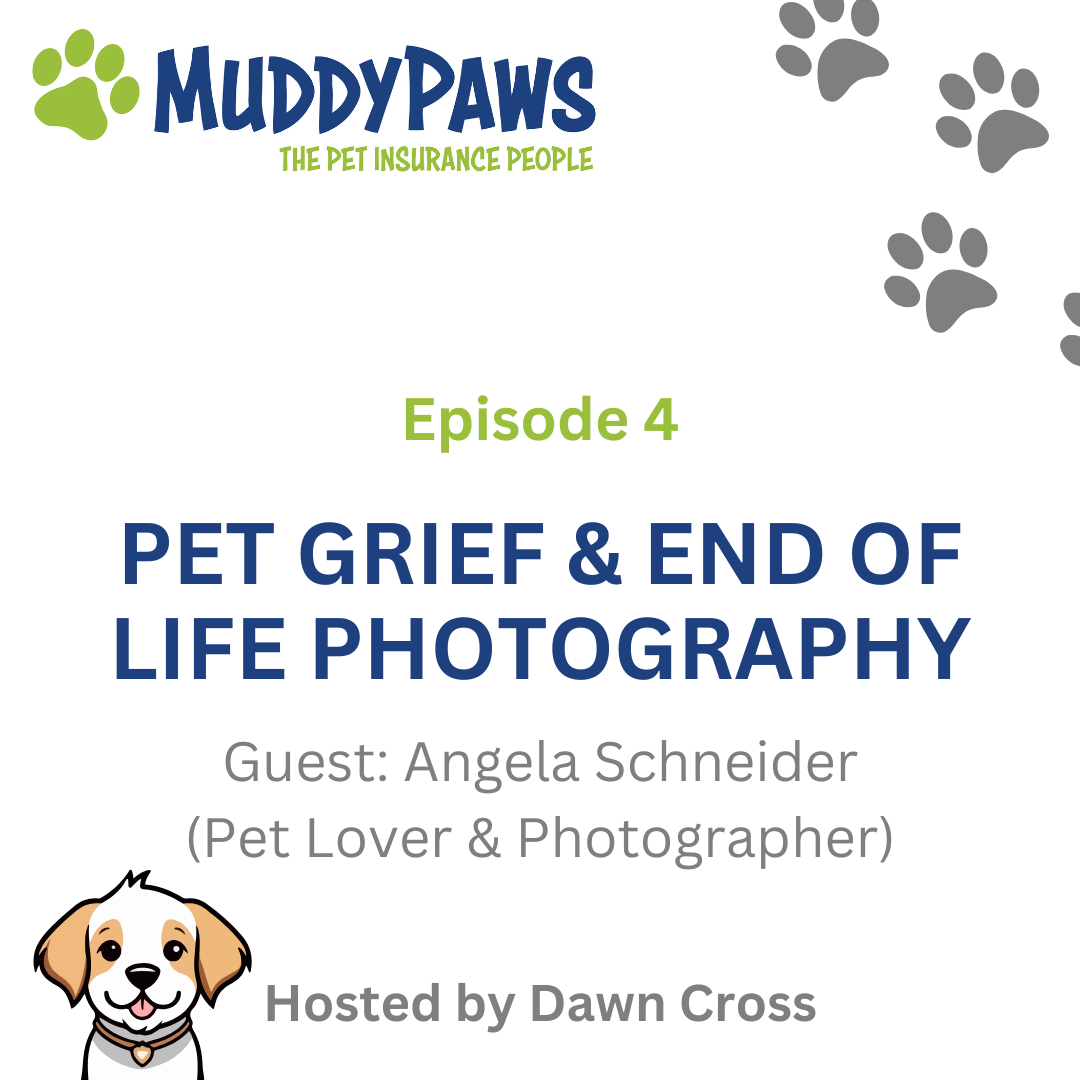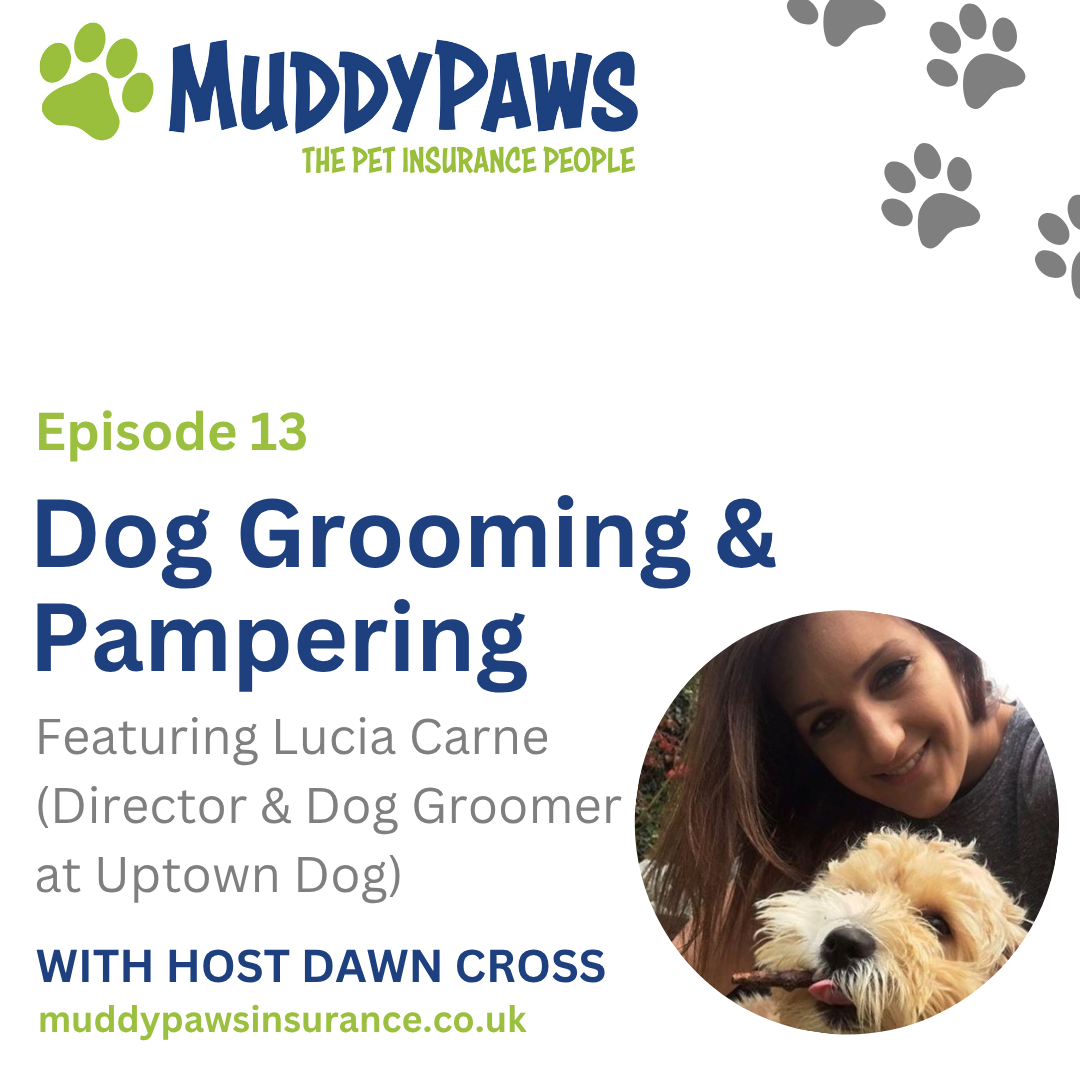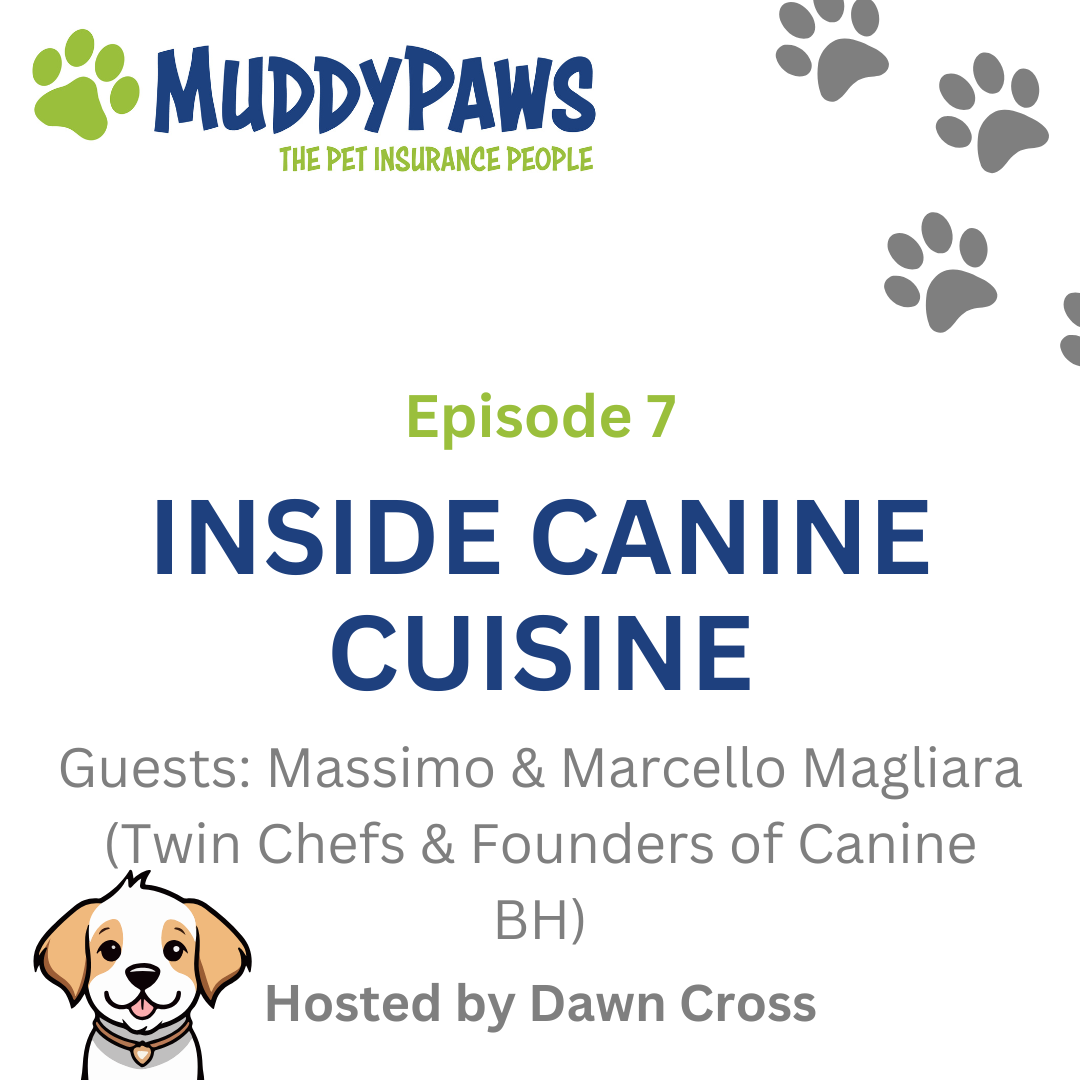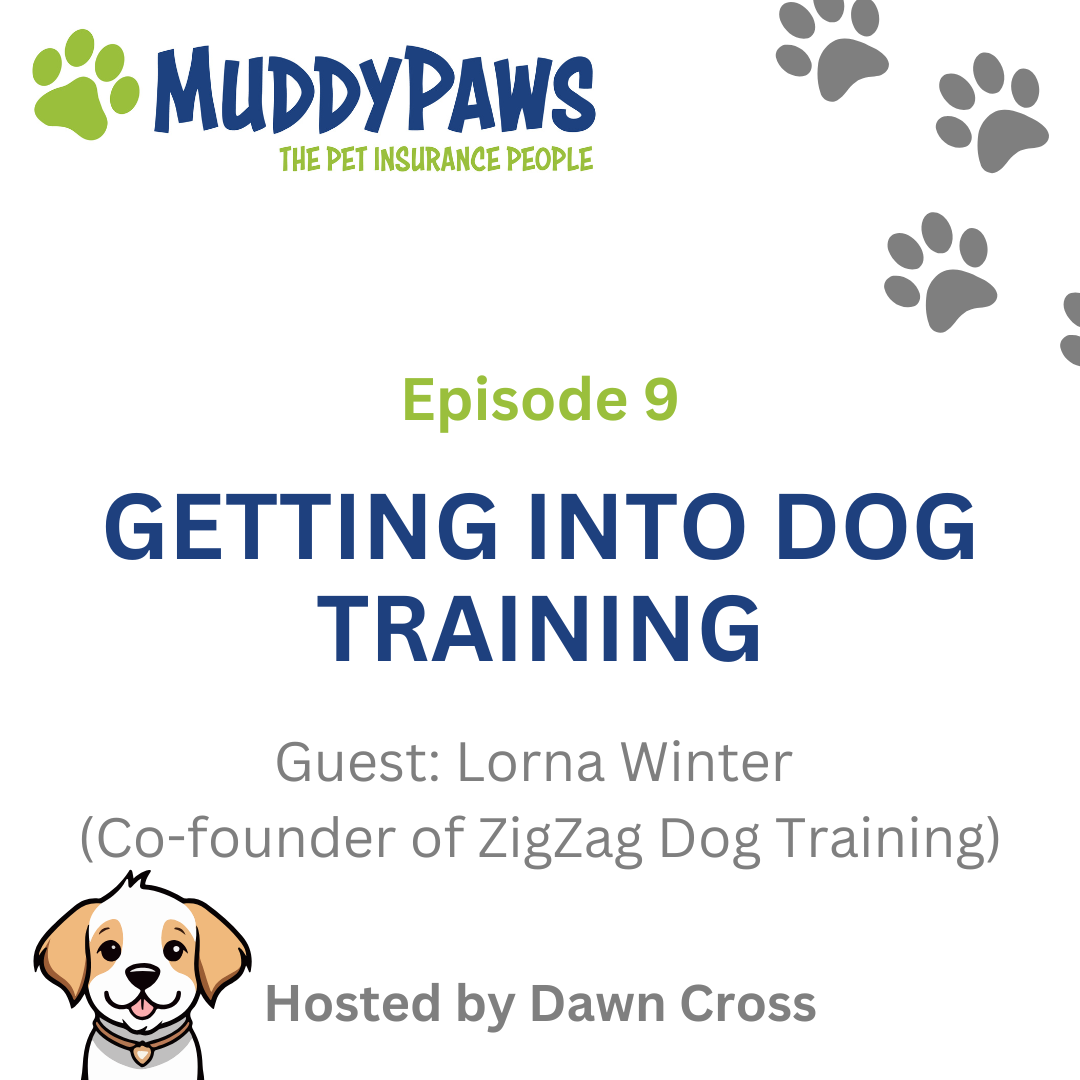Episode Transcript
[00:00:01] Speaker A: Welcome to the Muddy Paws Insurance podcast. I'm your host, Dawn Cross, and today I'll be discussing the human animal connection and canine cuisine with Jeannie Joseph, finder and writer.
If you enjoy our podcast, make sure to leave a rating on your favourite podcast directory.
[00:00:17] Speaker B: Excellent. So let's get started. Could I get you to introduce yourself and what you get up to at your company?
[00:00:23] Speaker C: Sure. I'm Jeannie Joseph, and I'm the executive director of the Human Animal Connection. And we're a nonprofit organization in the US, and we do lots of good things with animals and people. So we'll bring therapy animals to people who are having stress or having a rough day. Like, well, one of the things we do is we go and visit the 911 operators. I don't know if you have 911 in your country, but this is the police, fire, an ambulance. So these are people who are talking to people at the worst moments in their lives. You know, the worst things are going on, and they're getting these calls all day long. It's quite an experience. And one day, I brought Harry in, one of my therapy dogs, and the supervisor got off a phone call, and he looked at Harry and he said, thank God Harry was here today, because I just had a call that really got under my skin. I try not to let them get under my skin, but this one did, and it wasn't for Harry. I don't know what I would do. You know, it's just very sweet that people who, you can bring some joy, just a moment, just a little cuddle, a little sweetness that can just take away the stress and bring a smile to people's faces, let them go back to what they have to do. So we do that, and we have a program called Canines Teach compassion. And this is our high school program, and we bring the therapy dogs in to work with high school students. And as you know, high school students are under a lot of stress, and it's really beautiful to see them kind of, you know, they don't want to talk about their emotions, necessarily. The last thing they want to do is do therapy. Right? So, you know, the dogs come in, and the dogs connect with them in a way that's beyond words. You know, it really. Yeah, it just. It touches their hearts, and it gets them out of that kind of teenage angst, that sort of, you know, I don't fit in. How am I going to fit in? What do I, you know? And one of the things we'll do, we'll line up five different dogs in our program. We'll have a big, you know, Harry's this big, great Pyrenees mix, and my other dog, Sophia, is this little 25 pound Chihuahua mix. And, you know, all these different dogs, black dogs, all different colors, line them all up, and we say to the kids, what is different about them? And immediately they can see all the differences. And then we'll say, well, what's the same?
And it makes the point that that's how we are, too. You know, on the outside, you can see all these differences, but on the inside, there's a fundamental sameness of humanity, and that helps people to reconnect with their hearts. And we have a saying that you can't be compassionate to others until you're compassionate with yourself, meaning how you talk to yourself, how you treat yourself. And so we are really interested in helping kids treat themselves better, you know, be nicer to themselves, because there's so much, you know, difficulty outside, you know, fitting in all this, the world.
[00:03:10] Speaker B: Yeah.
[00:03:11] Speaker C: And it just helps if you're not your own worst enemy.
[00:03:16] Speaker B: I definitely agree. That's amazing. So how did you get started into all of this? Like, was it a specific idea? You've always been an animal lover?
[00:03:24] Speaker C: Well, no, actually. I mean, it's not that I didn't always love animals, but I was in the movie. I was in the movie business for 25 years, and I had a type a personality life. Not that I do now, but, you know, so I had no room.
There was no room for love, you know, so I just did, you know, it wasn't something. I had a cat towards the end, but, you know, which I love. She was. He was amazing. But I began doing this program for service members, for soldiers, for all branches of the military, using improv, comedy and laughter and expressive arts. And. And about two years into that program, it was very effective. But about two years into that program, I started bringing in the therapy animals, the dogs, the horses, miniature horses. And I saw what the dogs could do, and I was like, oh, my God, why am I working so hard?
It's like the dogs can reach people in ways that, you know, would take months for me. And I had this one rescue dog. His name was Oscar, and he had been himself a prisoner of war. He had been. I won't tell you all the horror, but it was horrible. And he had escaped with a very, very expensive gps collar. This is, you know, many years ago. So it was like a $1000 collar, and they didn't even claim him because they didn't want people to know what they were doing. But anyway, he. So he had missing teeth, scars all over his body. He had this really sad look. But he was an extraordinary therapy dog. And from day one, he could. He could sit. I would work with a group of soldiers in the hospitals hospitalized with PTSD. He would go and he would say hello to each one. He would know someone was afraid he would skip them. Benny would go the next one. But then he would just, what we call, do an alert, which is he would sit in front of the person who most needed help in that moment. So he would just sit there and look at them with these big brown eyes until the person just melted, you know, and it was. He was always right. I mean, he, you know, like, because people would hide their. Especially this, the early days, you know, in the war, and people would hide their emotions because, no, they didn't want people to know they were suicidal or having those thoughts or feelings. So Oscar always knew. And I really began to trust the instincts, his instincts, you know, he was impeccable. You know, humans could lie with their words, but you can't lie to a dog because they, they feel energy, you know, they feel it. And he would do that with kids, too. So that just said, you know what? This is it. This is the. This is what I want to do. And so now here we are at the human animal connection. And, you know, we have worked with over 4000 service members and now we do some visits at the VA, the veterans hospital here. And, yeah, it's good. It's a good. It's a good thing.
[00:06:10] Speaker B: I love that. Yeah, I know. Pets just always just kind of know when you're not feeling okay. Like, you know, whether you see a therapy dog once a week or you have your own pet, they just have that sense. It's amazing. And they're like, you know, you could just spill all your secrets and, you know, you can have a good, like, therapy session with them, just chatting at them and obviously they're just there cuddling you and, you know, even if they can't, you know, give, you know, constructive feedback to you, at least it's really nice that you get to have that connection. And it's amazing that obviously, you're utilizing how amazing those animals are to help others, especially in their most dire moments.
[00:06:46] Speaker C: Absolutely. Because, you know, connection and love goes a long way towards healing. It's not to say that we don't also need to sometimes talk and have those experiences, but sometimes those are not what we need. Sometimes we just need to feel our own heart beating, you know? And when you're in the presence of an animal, and you just, you know, they just being sweet and snugly to you. You just feel sweet and snugly back, and pretty soon you feel your. Your own humanity, you know, your own nature. You start to feel reconnected with yourself and with the dog. So it's not just connecting with the dog, it's connecting with your own goodness. You know, when we say good doggie, you're a good doggie. My doggies are looking at me now. I'm saying that, you know, when we say that it's good for them, but it's also good for us because it brings us into the feeling, the experience of goodness. And goodness, like every emotion is contagious. You know, all emotions are contagious, the good ones and the bad ones. So we definitely want to work with that. That, you know, really, that circle of energy back and forth from the animal to the person. And, you know, not all animals have the destiny of being therapy animals. It's maybe about 20% if I'm going to. It's not a scientific number, but just observationally, I see about 20% in the shelter, about 20%. The dogs are really, really. That's their destiny.
And when it's their destiny, they love it. You know, they have, they are so good at reading human emotions and human energy and human moods. You can't teach that. You know, you can teach them other skills, but either they either feel emotions or they don't. And some dogs are just happy to be pets and play fetch and be just doggy. And nothing wrong with that. You know, that. That's 80% of dogs are probably very happy just doing that. But in our program, one of the things that's really important to us is that we want to make sure that the experience is as good for the animal as it is for the human. So we don't use animals as tools of healing.
We work with animals as partners in healing. So that's maybe one of the things that makes our program unique, is that in the human animal connection, I've written a book about it, and I talk about the 33 principles that underlie all of this and these healing techniques and working with animals, with trauma.
And one of our principles, I can't remember which one, I think it's 17, is that animals have opinions, and just having that perspective makes you aware, oh, is the dog tired now? Has he had enough? Has that person, just like, you know, taking on all that energy, that person, maybe it's time to go home now, you know, after 45 minutes, you know, they can't work all day if they're, you know, working with people with stress, because they do take on the energy. And as humans, it's our. As the handler, we call them the handlers. The person who works with the dog team, we. They have to be very observant because if a dog goes past that point, either they're going to get debilitated or, you know, they're going to be crabby or not want to engage. So, because they're very truthful about their emotions. But we have to be observant. We have to watch. Of course. Yeah.
[00:09:51] Speaker B: And obviously they can't just say, I've had enough. Give me a break.
[00:09:54] Speaker C: I need.
[00:09:54] Speaker B: I need a day with a ball and I'll get back to you tomorrow.
[00:09:58] Speaker C: Exactly. Well, they do say it. They just don't say it in words. They say it in behavior. But that behavior may be so subtle that if you're not paying attention, it's very easy to miss. You know, it could be simply, you bring a dog up to the person, dog turns their head away and it's like, oh, he hasn't done that all day. You know, he's met ten other people. That's the first time he's trying to turn it away. So either he's not feeling like engaging with that person's energy, or maybe he's just had enough for the day. And so that's our responsibility, is to be alert to what the dog is showing us. You know, obviously they're not going to say it in words like you said, but they're going to show it in their behavior.
Definitely.
[00:10:39] Speaker B: Brilliant. I would love to know, actually, now, about your new book that you had mentioned previously about the wholesome canine cuisine. What's that all about?
[00:10:49] Speaker C: Yeah, so I've just written a new book which you can get on Amazon. It's called wholesome canine cuisine, and it's all about making homemade food for your dog. And the great thing about my program is that I'm not like one of these fanatics. Like, you have to do 100% homemade, even if you do 25% homemade or 50% homemade, it's whatever you can manage, because we all have busy lives, but. And, you know, obviously, commercial dog food is very convenient, but it's not healthy. And Doctor Marty Goldstein, veterinary in the US, when he was in, he says when he was in veterinary school in the 1970s, he saw one in ten dogs would get cancer, and it was only senior dogs. And today, I don't know what it's like in the UK, but in the US, now it's one in two dogs will get cancer and at any age. And one of the distinct differences is that in the old days, dogs used to eat human food. You know, like, it used to be dogs got the food, you know, scraps from the table or whatever, the. Whatever was left over. So they were eating, you know, essentially nutritious food that still had its nutrient values. And today they're. They're getting these processed food. And kibble, for example, the dry food. Do you call it kibble in the UK? I don't know what you call.
[00:12:04] Speaker B: I think normally it's either like, dry I food or biscuits. We tend to call it dry food or biscuits.
[00:12:08] Speaker C: Yeah, well, in order to make that, it has to be heated to 400 degrees in order to make that food. And when you heat anything to 400 degrees, it is dead. It is nutritionally dead. Nothing survives 400 degrees. And the reason that they have to heat it to such high temperatures is because of all the pathogens from the poor quality of the food that's being used in the pet food industry, because it's not regulated. The government does not regulate what goes into pet food. So they, pet food manufacturers have a lot of liberty about what they put in, and they put in things that are not human grade, things that we would not consider eating. And so that's, of course, why it has to be heated so high. And in fact, I don't know how it is in the UK, but in the US, they have found a lot of the medications used in euthanasia showing up in the dog food, because dogs that have been euthanized end up as dog food. So, yeah, it's really awful. The more you learn about it, the worse it gets. So, you know, just by, if you're, you know, if you're a vegetarian, it's a little harder. But if you're not a vegetarian and you're, you know, and you're boiling up some chicken, so give the dog some chicken. You know, give the dog some beef, give the dogs a little bit of pork. Not too much. Cause it's a little fatty. But, you know, very. You wanna vary the proteins, you wanna add a little bit of vegetables, but the vegetables need to be cooked a little bit or pureed because they can't break down the vegetables in the raw form. So you don't wanna give raw vegetables, but a little bit of vegetables and a little bit of healthy grains. Like, there's a kind of a trend in the US where they say grain free pet food, which is just a pure marketing hoax. There's no evidence that that is a good. Good for dogs. In fact, we have a lot of cardiomyopathy in dogs that is perhaps being linked to the lack of healthy grains. So when I say grains, I'm talking about maybe 10% of the meal, but some oatmeal or some quinoa or some healthy grains, some healthy fruits. Blueberries, you can throw some blueberries in. So whatever you're eating, three dogs, they get their regular doggy breakfast, but then I make scrambled eggs for myself, so they get some.
So they get a little scrambled eggs, a little bit cheese, and whatever I have. If I have some yams, I'll put a little in. So you can improvise. Once you learn the basic elements of canine cuisine, once you learn the basic elements, what vitamins they need, what nutrients they need, and I do use some supplements, so I add to it. And again, it's. I'm not 100%. Some days are 100%, some days are 50%. You know, it doesn't go below about 50. But I, you know, add to some of the, you know, much higher qualities. Like I have. There's one brand in the US that's 100% food grade, so it's a little, obviously, more expensive than what you're going to find in, you know, the big stores, but they'll have some of that and some of the homemade, and it's amazing. I mean, my. The reason why I got started with this is my dog, Sophia, who's now ten. She had cancer twice, and that's what made me start to think I got to do something. So that's what got me on the journey. And she's doing very well now. She's just, you know, you know, she's bouncing around and been a happy little girl.
[00:15:21] Speaker B: Well, that's good. I'm so glad that she's okay now. It's amazing how you've drawn on your own experience as well. And obviously, you've not necessarily just kind of gone off kilter. You've actually, you know, done the research, had a look, and, you know, actually, there's a bit of a trend going on. I know, especially in the UK, like, things are a bit more regulated, but I have seen such a big difference from, you know, juicing or giving more of human food. But obviously the safe kind, you can't just give any human food just as a disclaimer and doing that instead of, you know, just focusing purely on what you can buy in the pet store, because it's. It can just be so much. It can just be so much fresher as well. Like, fresh food has got such a big difference, especially in animal diets. It's insane. And it's something I think everyone should definitely consider.
[00:16:07] Speaker C: Absolutely. And again, you can do it at a pace, at a level that works with your own lifestyle. Like, I'll make. I cook for them twice a week, usually put it in the refrigerator. I'll freeze some stuff, pull it out. So it's not like I have to cook every day, every meal, you know, but it's once you sort of get your kind of routine down, it can become very convenient. And like I said, I was in the movie business. I didn't even know where the kitchen was, you know?
So it's helped me, too, to think about, okay, what are we going to eat tonight? Not what's the dog going to eat, but what are we going to eat tonight? You know, just.
[00:16:42] Speaker B: Yeah, it probably just reinforces with yourself as well as like, you know, actually, you know, I'll try and make sure to have definitely some greens in this meal because I know I want to give some to my dog as well.
[00:16:54] Speaker C: Exactly.
[00:16:55] Speaker B: Kind of like, you know, supporting each other through healthy eating. It's. It's quite actually probably a good diet hack in a way.
[00:17:01] Speaker C: Right, right. Yeah. And we want to kind of eat the rainbow. So, you know, so we want to have, you know, a little bit of cooked carrots, a little bit of cooked broccoli, a little bit of cooked spinach. Important, as I said, to cook the vegetables because they don't break them down. And some people say, well, wolves didn't eat vegetables. Well, when wolves were out there, they would eat, like, if they ate, you know, a prey animal, they would eat the whole animal that ate some vegetables. You know what I mean? So they were getting a lot of vegetables and a lot of nutrients, and they do, they have learned that wolves did eat some fruit and some vegetables in addition. So, you know, this is, we're just beginning to understand canine nutrition, that when vets still today do not get any training in canine nutrition. And it's. It's the number one thing that we need to do to keep our dogs healthy.
[00:17:48] Speaker B: Definitely, I think it's something that definitely needs more research, but it's great that people like yourself are able to kind of have done the research. And obviously now I've got a brilliant resource for everyone else to refer to or even just, you know, obviously through this podcast episode, I'm sure it's enlightenment. It will enlighten a few people, at least. I know exactly I'm a bit more enlightened than I was when we started.
[00:18:07] Speaker C: So, yeah, yeah. I mean, my, my. When I first got. When I first rescued Sophia, you know, I gave her kibble because that's what they told me at the shelter. You know, take this bag of kibble that, you know, is one of the brands. You know, one of the brands that the shelters. Everyone goes home with this brand, let's put it that way. And it's not a good brand. It's. It's a well known brand, but it's not a good brand, you know? And so that's what I started with, because I didn't know she was my first dog. I, you know, I got my first dog at age 60, and so I had a lot to learn. I still have a lot to learn, but I've learned a few things along the way.
[00:18:43] Speaker B: That's brilliant. I was wondering if you could give us a little bit more insight. Obviously, you don't have to give away the full book, but, like, what kind of content does the book hold for any of those interested in possibly buying it?
[00:18:54] Speaker C: You're talking about the whole slime canine cuisine or my book, the human animal connection.
[00:18:58] Speaker B: Oh, the canine cuisine one.
[00:19:00] Speaker C: Yeah. So the canine cuisine has just lots of information. So it has 111 recipes, for one thing. And it has, like, explanation of what vitamins and nutrients dogs need. Talks a lot about. About getting the gut biome imbalance. A lot of the digestive issues that dogs are having, skin issues are really about gut issues. So understanding about getting the gut back in balance often will result in either eradication of other symptoms or better health in general. Because when our gut doesn't have the nutrients that it needs, if they're on commercial dog food products exclusively, their gut is often imbalanced, the gut microbiome. And these are the little critters that live in the gut that keep us healthy, both for humans and for animals. So in the natural world, they don't have to worry about that because they're eating alive things. They're always eating live things. But in our modern culture, they are suffering from overly processed foods just as we are. So I go through all of that and explain about the poop details of the colors and texture of poop. I mean, a lot of very technical information. People can just either go right to the recipes or they. I recommend at least learning the basics, and then from there, you can improvise once you understand kind of the core issues. And I also give a list of the top supplements that I recommend. Obviously, there's 15,000 pet products in the market. I haven't tested them all, but I have found some. And working with holistic veterinarians that I've consulted with, I've gotten their list. And so I have a kind of. So you don't have to start from zero. I mean, if you already know what you like, great. But there are, like, for example, it's really important for dogs to chew on bones. It's really healthy for them emotionally, mentally, and physically. But I'm not about to have all these bones laying around the house. And with three dogs, I don't want competition. So there's one company that makes a bone meal. It's a powder, and it's. And it's got all the nutrients that they need in the bones. Of course, it doesn't give them the chewing. Then I have to give them something else for the chewing, but, you know, not something that's going to be biodegradable in the house, you know? You know, I mean, we have to make it work for us, too, or we'll quit. We won't continue with it. So there are things like that that give all the list of my top resources.
I have lots of probiotics that I recommend. I have one company that makes the best, highest quality broccoli powder ever. I mean, it's like human grade. You can use it, too. And it's from the broccoli. I forgot. I think it's broccoli when it's not fully sprouted yet. It's the most healthy part, and that's all in powder form. So if I don't feel like making broccoli that day, just, I'm going to sprinkle a little bit of that broccoli powder in. So, you know, things like that. That company's called cornucopia, and it was started in the fifties by a veterinarian who realized that something was not right, and he started experimenting with giving dogs homemade food. So 50 years, he's been, he's been perfecting this recipe. So.
[00:22:06] Speaker B: Wow, that sounds amazing. Do you have any other kind of last minute tips, then, before we wrap up the episode?
[00:22:14] Speaker C: Well, there, I would say if you consider the possibility that animals have opinions, even if you don't know what they are, even if you feel like, how could I possibly know what he or she is thinking? Just taking the position that they do will make you pay more attention to the subtle signaling through behaviors. So I have a saying that all dogs are good dogs, but not all behavior is good behavior, but all behavior. It comes from an emotional issue. So if you can understand the emotions, then you can get to the bottom of behavior. You don't have to say bad dog. You know, you can understand. Okay, well, he's scared right now. That's why he's acting crazy, you know? So to help people understand that dogs have emotional lives, they have emotional needs, and to just recognize that doesn't mean that you're going to be able to fulfill it 100%, 100% of the time. But even if you fulfill it occasionally, you're going to have a deeper bond, a deeper connection, and that relationship is going to be more profound because you're communicating at a deeper level. Level.
[00:23:19] Speaker B: Yeah. That sounds absolutely amazing. Well, thank you so much for giving us your time today.
[00:23:24] Speaker C: Yeah, it was great to be with you.
[00:23:27] Speaker A: Thank you to my guest today, Jeanie, for chatting about her company in canine nutrition. If you're interested in her books, make sure to click the links in the description.
I have been your host, Dawn Cross, and make sure to click follow for more episodes.
Muddy Paws takes pride in keeping things simple. All the goal is to provide a reliable insurance policy that's well delivered and gives you peace of mind. Intelligent underwriting, a user friendly application, and outstanding customer service ensure we stand out from the crowd and provide the best for your furry friends.
